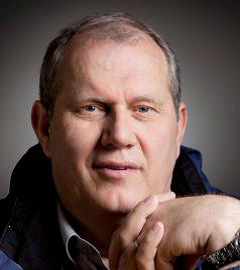
Просмотров: 1896
6-й семинар по металлоорганической химии под эгидой РНФ (грант 14-43-00017)

22.09.2015 в 17:15 в конференц-зале Ресурсного центра ЯМР (1093) пройдет 6-ой Семинар по металлоорганической химии под эгидой РНФ (грант 14-43-00017). С докладом "Are Detailed Reaction Mechanisms Really Necessary in (Applied) Organometallic and Coordination Chemistry?" выступит профессор Андре Руудт (Блумфонтейн, ЮАР).
Andreas Roodt received his PhD in Inorganic Chemistry from the University of the Free State (UFS) in Bloemfontein, South Africa, in 1987. He is currently distinguished professor in Chemistry and Chairperson of the Chemistry Department at the UFS, and leads the Inorganic Chemistry research group consisting of four senior colleagues, three post-doctoral fellows, ten PhD and eight MSc students. His prime research focus is on reaction mechanisms in Coordination Chemistry and chemical processes with application in homogeneous catalysis, separation technology and radiopharmaceuticals. For this he employs X-ray crystallography, reaction kinetics, equilibrium and time resolved NMR, IR and UV/vis spectroscopy at ambient, low and high temp and pressure, and Computational Chemistry. He collaborates with South African industries such as SASOL Technology, the Nuclear Energy Corporation of South Africa and Pet Labs Pharmaceuticals, and international research groups in Switzerland, Sweden, Germany, Russia and the USA. He made more than 25 international research visits as visiting professor to universities in Switzerland and Sweden and is a full member of the Academy of Sciences of South Africa. He currently serves as president of the European Crystallographic Association (35 member countries across Europe, the Middle East and Africa), is a Fellow of the Royal Society of Chemistry, an international elected member of the Swedish Physiographic Society as well as the International Advisory Board of the Rudjer Boskovic Institute, Zagreb, Croatia. He was the winner of RSA Department of Trade & Industry Award for the best THRIP research programme focusing on Small and Medium Enterprise Development in 2010, was chairperson of more than 20 international conferences in South Africa and abroad, and presented more than 70 lectures at international venues. In 2014, he was awarded a special medal from the Moroccan Crystallograpjic Association at IYCr2014Africa, for his efforts to expand science and crystallography in Africa. He regularly reviews papers for more than ten international chemistry journals, served on the editorial boards of three international scientific journals and has published more than 250 scientific papers and chapters in books (ISI Web of Knowledge H-index of 30).
Are Detailed Reaction Mechanisms Really Necessary in (Applied) Organometallic and Coordination Chemistry?
Andreas Roodt
Department of Chemistry, University of the Free State, Bloemfontein 9300, South Africa; roodta@ufs.ac.za
Many dynamic processes occur at the molecular level, thus fundamental understanding of structural behavior, and the associated influence on (kinetic) properties is of prime importance. Yet, the importance of detailed mechanisms is often overlooked, in particular by Industry.
This presentation emphasizes the continued relevance of small molecule crystallography in coordination chemistry in conjunction with an integrated mechanistic approach utilising time resolved spectroscopic techniques and specifically reaction kinetics, to counteract trivialized conclusions based on thermodynamic observations alone [1]. It focuses on structure/reactivity relationships and describes examples studies from our group over the past few years in areas related to homogeneous catalysis (olefin oligomerization, carbonylation, hydroformylation and methoxy carbonylation) [2] or with medical relevance (radiopharmaceutical models and chemotherapy) [3].
[1] Roodt, A.; Visser, H.G.; Brink, A. Crystallogr. Rev. 2011, 17, 241.
[2] Examples: (i) Hennion, C., Jonasson, K.J., Wendt, O.F., Roodt, A. Dalton Trans. 2013. 42: 14134; (ii) Cloete, N., Visser, H.G., Engelbrecht, I., Overett, M.J., Gabrielli, W.F., Roodt, A. Inorg. Chem. 2013, 52, 2268; (iii) Brink, A., Truedsson, I., Fleckhaus, A., Johnson, M.T., Norrby, P.O., Roodt, A.,Wendt, O.F. Dalton Trans. 2014. 43: 8894.
[3] Examples: (i) Brink, A.; Visser, H.G., Roodt, A. Inorg. Chem. 2014, 53, 12480; (ii) Alberto, R.; Schibli, R.; Waibel, R.; Abram, U.; Schubiger, A.P. Coord. Chem. Rev. 1999, 901; (iii) Schutte, M.; Kemp, G.; Visser, H.G., Roodt, A. Inorg. Chem. 2011, 50, 12486; (iv) Brink, A., Visser, H.G., Roodt, A. Inorg. Chem. 2013, 52, 8950; (v) Twala, T.N., Schutte-Smith, M., Roodt, A., Visser, H.G. Dalton Trans. 2015, 44, 3278.


